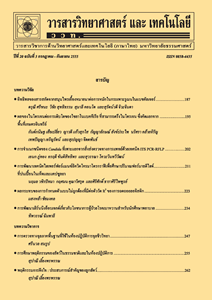การพัฒนากระบวนการผลิตกาละแมเพื่อยืดอายุการเก็บรักษา
Main Article Content
Abstract
บทคัดย่อ
กาละแมเป็นขนมไทยพื้นบ้านที่มีอายุการเก็บรักษาสั้น (ประมาณ 7-30 วัน) โดยมีเนื้อสัมผัสเปลี่ยนไปจากเดิมไม่เป็นที่ยอมรับ งานวิจัยนี้จึงมีวัตถุประสงค์ในการพัฒนากระบวนการผลิตเพื่อการยืดอายุการเก็บรักษา โดยผลิตกาละแม 3 วิธี ดังนี้ วิธีที่ 1 กวนโดยเติมส่วนผสมทีละส่วนและไม่ต้มกะทิ วิธีที่ 2 กวนโดยเติมส่วนผสมทีละส่วนและใช้กะทิต้มกับน้ำตาลก่อนเติมในส่วนผสม วิธีที่ 3 ผสมส่วนผสมทั้งหมดให้เป็นเนื้อเดียวกันก่อนนำไปกวน วิเคราะห์ผลทางเคมี ทางกายภาพ ทดสอบทางประสาทสัมผัสกาละแมแต่ละวิธี และเปรียบเทียบกับกาละแมในท้องตลาด พบว่าผลทดสอบทางประสาทสัมผัสและผลวิเคราะห์ทางกายภาพของกาละแมผลิตตามวิธีที่ 3 มีค่าความแข็งมากที่สุดและมีค่าความสามารถในการยืดน้อยที่สุด กาละแมวิธีที่ 1 และวิธีที่ 2 มีค่าความแข็งและความยืดหยุ่นไม่แตกต่างกัน ทั้งกาละแมวิธีที่ 1 และวิธีที่ 2 มีค่าความยืดหยุ่นมากกว่ากาละแมในท้องตลาดอย่างมีนัยสำคัญทางสถิติ (p≥0.05) ผลการวิเคราะห์ทางเคมีพบว่ากาละแมวิธีที่ 2 มีค่า TBA มากกว่าวิธีที่ 1 และวิธีที่ 3 แต่น้อยกว่ากาละแมในท้องตลาดอย่างมีนัยสำคัญทางสถิติ (p≥0.05) ผลศึกษาการเปลี่ยนแปลงเนื้อสัมผัสของกาละแมบรรจุในฟิล์ม metalized CPP/OPP และฟิล์ม OPP/CPP ระหว่างการเก็บรักษาที่อุณหภูมิ 25-30 องศาเซลเซียส เป็นเวลา 75 วัน พบว่ากาละแมวิธีที่ 2 ในฟิล์ม metalized CPP/OPP และฟิล์ม OPP/CPP คงลักษณะความยืดหยุ่นของเนื้อกาละแมไว้ได้ดีกว่ากาละแมวิธีที่ 1 อย่างมีนัยสำคัญทางสถิติ (p≥0.05) ดังนั้นการยืดอายุการเก็บรักษากาละแมควรเลือกการผลิตโดยการต้มกะทิกับน้ำตาลก่อนเติมส่วนผสมและควรแยกเติมทีละส่วนตามลำดับ
คำสำคัญ : กาละแม; ขนมหวาน; ค่า TBA; อายุการเก็บรักษา; ลักษณะเนื้อสัมผัส
Abstract
Kalamae, one of Thai traditional desserts has a short shelf life (7-30 days) due to its texture changes. The purpose of this research was developing processes to extend the shelf life of Kalamae. Three process methods were studied as follows: the first method and the second method were done by adding each ingredients orderly, one used fresh coconut milk, the other used boiled coconut milk with sugar; the third method was done by mixed all ingredients together before cooking. Physical and chemical characteristics and sensory evaluation of each processed kalamaes were determined and also comparison with commercial kalamae. The results of sensory evaluation and physical determination showed that Kalamae prepared by the third method was significantly highest in hardness and least springiness, while prepared by the first and the second methods showed no significantly different of hardness and springiness (p≥0.05). Both the first and the second methods showed higher springiness than commercial Kalamae. Results of chemical analysis showed the TBA value of Kalamae prepared by the second method was significantly higher than the others, but lower than commercial Kalamae (p≥0.05). The study of texture changes of Kalamae during storage in metalized CPP/OPP and OPP/CPP films at 25-30 °C for 75 days. It was found that the second method Kalamae in metalized CPP/OPP and OPP/CPP films could remain tensile strength value significantly better than the first method Kalamae (p≥0.05). Therefore, for longer shelf-life of Kalamae, the recommended process to making Kalamae was using boiled coconut milk with sugar, and added each ingredients orderly during cooking.
Keywords: Kalamae; dessert; TBA; shelf life; texture


